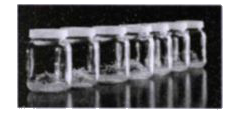Bacteria multiply at a rate proportional to the number present. If the original number N double in 3 hours, the number of the bacteria will be 4N is (in hours).
To solve the problem where bacteria multiply at a rate proportional to the number present, we can follow these steps:
Step 1: Set up the differential equation
Given that the rate of growth of bacteria is proportional to the number present, we can express this mathematically as:
dNdt=λN
where λ is a constant.
Step 2: Separate variables and integrate
We separate the variables to integrate:
dNN=λdt
Integrating both sides gives:
∫dNN=∫λdt
This results in:
lnN=λt+C
where C is the constant of integration.
Step 3: Solve for the constant C
At t=0, let the initial number of bacteria be N0. Substituting these values into the equation:
lnN0=λ⋅0+C⟹C=lnN0
Thus, we can rewrite our equation as:
lnN=λt+lnN0
Step 4: Simplify the equation
Rearranging gives:
lnN−lnN0=λt⟹ln(NN0)=λt
Step 5: Use the doubling condition
We know that the bacteria double in 3 hours. Therefore, when t=3:
N=2N0
Substituting this into our equation:
ln(2N0N0)=λ⋅3⟹ln2=3λ
From this, we can solve for λ:
λ=ln23
Step 6: Find the time when the bacteria are five times the original
We want to find t when N=5N0:
ln(5N0N0)=λt⟹ln5=λt
Substituting the value of λ:
ln5=ln23t
Solving for t:
t=3ln5ln2
Final Result
Thus, the number of hours it will take for the bacteria to become 4N is:
t=3ln5ln2
Given that the rate of growth of bacteria is proportional to the number present, we can express this mathematically as:
dNdt=λN
where λ is a constant.
We separate the variables to integrate:
dNN=λdt
Integrating both sides gives:
∫dNN=∫λdt
This results in:
lnN=λt+C
where C is the constant of integration.
At t=0, let the initial number of bacteria be N0. Substituting these values into the equation:
lnN0=λ⋅0+C⟹C=lnN0
Thus, we can rewrite our equation as:
lnN=λt+lnN0
Rearranging gives:
lnN−lnN0=λt⟹ln(NN0)=λt
We know that the bacteria double in 3 hours. Therefore, when t=3:
N=2N0
Substituting this into our equation:
ln(2N0N0)=λ⋅3⟹ln2=3λ
From this, we can solve for λ:
λ=ln23
We want to find t when N=5N0:
ln(5N0N0)=λt⟹ln5=λt
Substituting the value of λ:
ln5=ln23t
Solving for t:
t=3ln5ln2
Thus, the number of hours it will take for the bacteria to become 4N is:
t=3ln5ln2
Topper's Solved these Questions
Similar Questions
Bacteria increases at the rate proportional to the number of bacteria present. If the original number N doubles in 3 hours, find in how many hours the number of bacteria will by 4N ?
View SolutionIn a certain culture of bacteria, the rate of increase is proportional to the number present. If it is found that the number doubles in 4 hours, find the number of times the bacteria are increased in 12 hours.
View Solution
Knowledge Check
The rate of increase in the number of bacteria in a certain bacteria culture is proportional to the number present. If in 5 hrs the number triples, then in 10 hrs, the number of bacteria present is
A18 times the originalB12 times the originalC6 times the originalD9 times the originalRead the following text and answer the following questions on the basis of the same: The rate of increase in the number of bacteria in a certain bacteria culture is proportional to the number present. Given that the number triples in 5 hours.

If 'N' is the number of bacteria, the corresponding differential equation is ____________ .AdNdt=KtBdNdt=KNCdKdt=NDdKdN=tRead the following text and answer the following questions on the basis of the same: The rate of increase in the number of bacteria in a certain bacteria culture is proportional to the number present. Given that the number triples in 5 hours.

The bacteria becomes 10 times in ___________ hours.A5log7B5log10log3C5log3Dlog(1053)
Bacteria multiply at a rate proportional to the number present. If the original number N double in 3 hours, the number of the bacteria will be 4N is (in hours).
View SolutionThe rate of growth of bacteria is proportional to the number present . If initially, there were 1000 bacteria and the number doubles in 1 hours. Find the number of bacteria after 212 hours . [ take √2=1.414]
View SolutionThe rate of increase in the number of bacteria in a certain bacteria culture is proportional to the number present. Given the number triples in 5 hrs., find how many bacteria will be present after 10 hours. Also find the time necessary for the number of bacteria to be 10 times the number of initial present. [Given loge3=1.0986, e2.1972=9 ]
View SolutionRead the following text and answer the following questions on the basis of the same: The rate of increase in the number of bacteria in a certain bacteria culture is proportional to the number present. Given that the number triples in 5 hours.

If N0 is the initial count of bacteria, after 10 hours the count is __________ .
View SolutionIf the bacteria in a culture increase continuously at a rate proportional to the number present and initial number is N, then the number present at time t is
View Solution
